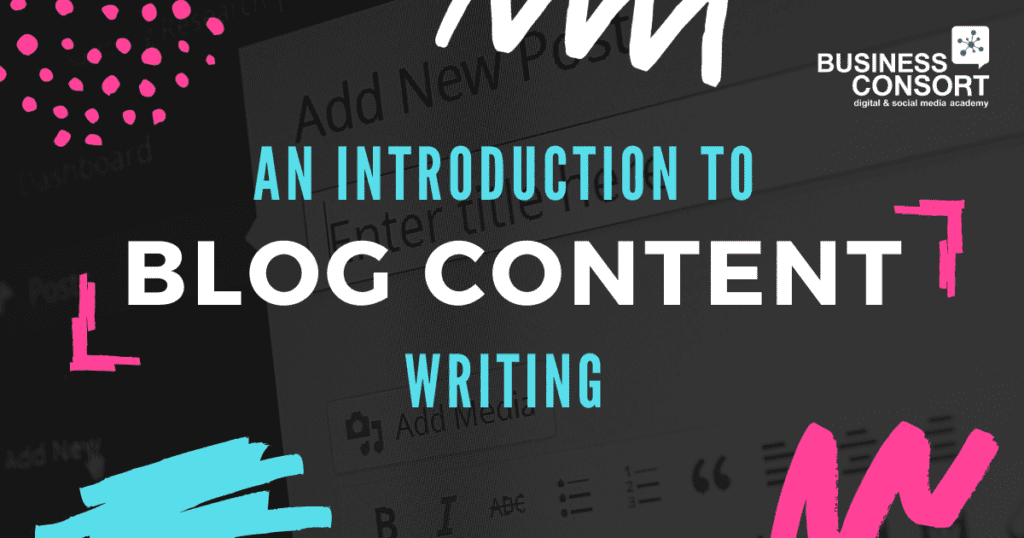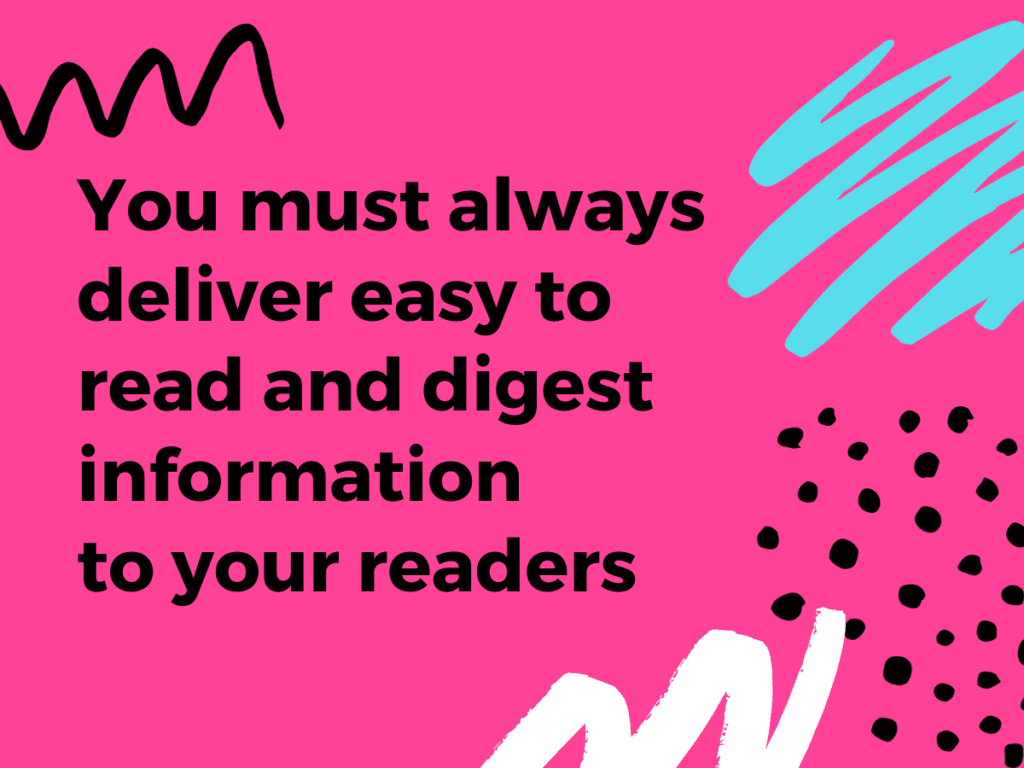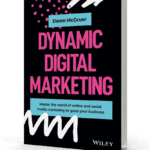An introduction to blog content writing

A good blog post should be exciting and educational. Your chief goal is to write the articles your customers want to read.
To do that, you need to know what they want, and what will make them want to come back for more. On top of that, you need to be eloquent, entertaining, and easy to understand.
What you really need is to make your pages and products irresistible.
If you’d like to know exactly what that takes, check out our blog writing courses online. Our digital marketing experts have all the information and experience to help you deliver outstanding, conversion-creating content.
With the right blog writing training, an okay website will transform into a wonderful and high-performing platform. Who wouldn’t want a piece of that?

Speaking from (vast) experience, practice, practice, practice. It might not make perfect—not everybody is built to be a journalist—but you will find your voice and how to use it to get the best from your readers.
Crucial elements and key considerations
The title or headline – the H1 tag
Your title is the first thing they’ll see. Along with your meta description, it drives traffic to your website. It also delivers the theme of what’s up for debate. It also carries the most powerful tag for SEO, so make sure your keywords are in there, pride of place.
Introduction
A good introduction should show your readers precisely what they’re going to find out in the full article. Making it sound exciting and informative outlines the pace and content for the rest of your text—so hit them early with your best lines.
Facts, figures, features, and fun (where appropriate)
You are a human. Your reader is a human. So write like one. Yes—you should absolutely stick with your brand tone and guidelines, so don’t fall into the trap of trying to sound too clever, or like somebody you’re not.
An actionable summary or conclusion
Don’t just leave your readers hanging; seal everything up with a neat and tidy message they can’t fail to miss. A story should have a beginning, a middle, and an end—and so should your blog.
Start as exciting and engaging as you can, keep the pace and your reader’s education flowing through the body, and then seal the deal with a crystal clear conclusion.
Those few items are just the start. Jump into any of the courses that cover blog writing in London, Manchester or online, and they’ll go over exactly what’s required of you to make the real magic happen.

Our 8-step plan to blog content writing
Only the most talented writers with limitless expertise in their topic will be able to sit down and fire out a page of beautiful text, one that keeps its reader engaged, and converts to a sale each time, on their first attempt.
The rest of us need to plan, write, check, and edit—over and over before we get it right. And that’s only the half of it.
We offer lots of free online marketing resources too as well as blog writing training online, so you shouldn’t ever be without reference material.
But as a start, in the limited space we’ve got to play with, the following should provide a good entry point into the craft.
1. Research your subject
When you have an idea of what you want to write about, you need to make a plan.
Research everything you need to know about what you want to say, and then decide how many words you’d like your piece to be.
If you’re going to wow your audience with facts and statistics, make sure you reference them so your visitors can see you’re authentic. Trust accounts for so much when it comes to brand confidence, so deliver any opportunity you can to earn it.
2. Plan your page – include SEO and optimisation
With an idea of what you want to say and how many words you’re likely to use to do it, figure out just how many paragraphs you’re likely to use for each section.
At this point, you can consider the images or illustrations you’d like to use to reinforce your message. Additional media goes a long way in breaking up all those big scary blocks of text.
3. Optimise your pages for SEO during blog content writing
For the search engines to have the best chance of matching your content to their searches, you need to box clever.
Your meta title and description should feature your main keyword and match your copy. There are myriad methods to find the best keywords and phrases—both short- and long-tailed options.
Add keywords to your images in the alt-text descriptions, and where you can, link to pages of popular websites, and also within your site. They’ll all add to your website and page SEO scores and ranking.
4. Create a structured outline
Loosely plan your sections and their hopeful headings.
Remember that headings are the best places for keywords and keyword phrases. They carry a lot more clout, so use that power well!
Many of our searches are typed as questions, so figuring out what people are asking and using those as headings is smart for SEO—as long as they make sense.
Make sure to let your readers know what reading your article will do for them. It’s the ‘why’ of the piece. Explain ‘why’ they need your product, or ‘why’ they should support your cause, and they’ll see the benefit to them and not just the product. You’re selling the sizzle, here, and not just the sausage.
5. Write each section of your blog – paying consideration to headings
There are all kinds of blog types, but they all utilise the same practices. It doesn’t matter which of the following types of blog you choose (you can dig into all of these much deeper on any writing for blogs course), you must always deliver easy to read and digest information to your readers.
· How-to blogs
· List-based blogs
· What is… blogs
· Guest post blogs
· Newsjacking blogs
· Infographic blogs
Writing for the web takes a different route to writing fiction. When writing fiction, you can create long, sprawling sentences, full of description, colour, and marvel, delivering the pace of the story in endless, extended prose.
For the web, you need to rein all that in from the outset.
Keep it short and snappy
When writing a blog, you need short, easy to digest sentences. Unless you’re publishing fiction or stories in your articles, you need to write in a style that gets the facts and figures across, and pushes your readers to a call to action, as efficiently as possible.
Each paragraph need only include a couple of short sentences. There’s nothing that scares an online reader more than huge blocks of text. How will they find what they need in all that? Break up paragraphs with bullet points or interesting headings to help guide your reader to what they want. Like this:
Stay on-brand and on-theme
Your readers may have stumbled into your blog through a variety of entry-points, but if they like it, they’ll expect (and hope) to find more of the same over the rest of your content.
What connects your articles? Is it you and your adventures? Is it the sport or activity under debate? Or is it that you review hundreds of different items—the common ground there, being the reviewing.
You should stick to the same tone, too. Blogging is about creating a relationship with your readers. If you jump from persona to persona, it will feel disjointed. Find your style and stick to it wherever you can.
6. Find the right images for your content and your voice
With the article fleshed out, you can decide whether the images you considered during the planning stage are still appropriate. If so, excellent. Grab your camera, head to the stock image sites, or call your graphic designer.
Facts and figures are better represented as infographics. The fun in your topics can be mirrored with appropriately entertaining photographs. And if it’s a product that you’re selling, can you access professional photography to show it off at its very best?
Include clear calls to action
The SEO in your blog is responsible for attracting readers. Your content is there to create desire, yet it’s your call to action that does the best job of all—it makes the sale.
You need it to be clear. Unmissable.
And you don’t have to settle for just one. If you’re selling a product, send your readers to your sales page. Why not sell them on a dozen different products if you can?
Additionally, why not see if you can grab their email address? You can try to sell them something different at another time if they don’t bite straight away.
7. Read, rewrite, re-read, and edit
Rome wasn’t built in a day, and so rarely is a great article great on the first try. Read over what you’ve written—where it doesn’t flow, or you find obvious mistakes, put them right.
If you’re not confident enough to make the big judgements, have someone you trust check your work. Ask them where it falls down. In time, you’ll recognise what works and what doesn’t, but there’s no shame in asking for help while you work on finding your feet.
8. Proofread and grammar check
When you’re happy with the feel and the flow, it’s time to move on to grammar and punctuation. Don’t trust the spell and grammar checks in Microsoft Word or whichever word processing software you use. If you’re creating commercial quality work, you should use a commercial quality spelling and grammar checker to make sure it’s absolutely flawless.
At this point, you’re as ready as you’re going to be. It’s time to post your latest work of art.
Blog content writing training courses
As you can see, we’ve filled this page with a whole load of great ideas to help you create much better articles—but we’ve barely skimmed the surface.
There’s plenty of blog writing training online, so don’t be afraid to get stuck into it.
Knowledge is power, as they say, education is everything, and practice makes perfect.
That said if you really want to get the best from the best, engage with an expert. Enrolling in a blog content writing course is a superb idea. We can help you with that and every other area of your digital marketing.
We’re waiting to hear from you.



